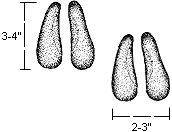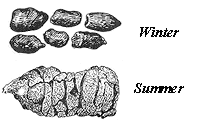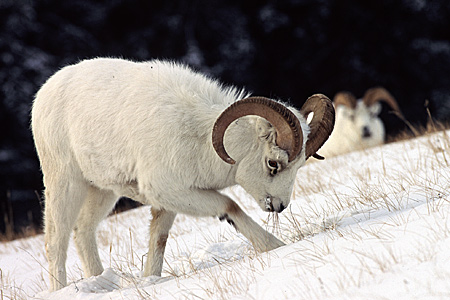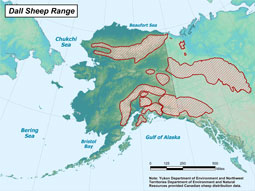Dall Sheep
(Ovis dalli dalli)
Printer Friendly
Did You Know?
Both rams and ewes have horns, but ewes’ horns are smaller and thinner
General Description
Dall Sheep (Ovis dalli dalli) inhabit the mountain ranges of Alaska. These white creatures are most notable for the males’ massive curled horns. Females (known as ewes) also carry horns, but theirs are shorter and more slender, and only slightly curved. Until rams reach the age of 3 years, they tend to resemble the ewes quite a bit. After that, continued horn growth makes the males easily recognizable. Horns grow steadily during spring, summer, and early fall. In late fall or winter, horn growth slows and eventually ceases. This start-and-stop growth results in a pattern of rings called annuli which are spaced along the length of the horn, and can help determine age. Dall rams as old as 16 years have been seen, and ewes have been known to reach 19 years of age. Generally, however, a 12 year old sheep is considered quite old.
Life History
Growth and Reproduction
Lambs are born to ewes in late May or early June. As lambing time approaches, ewes seek solitude and protection from predators in the most rugged cliffs available on their spring ranges. Lambs begin feeding on vegetation within a week after birth and are usually weaned by October. Ewes typically have their first lamb at age 3 or 4 and produce a lamb annually.
The first weeks of a lamb’s life are precarious. The bulk of the mortality is in first 30 to 45 days of life, when the lambs are most vulnerable.
Adult rams live in bands which seldom associate with ewe groups beyond the mating season in late November and early December. The horn clashing that rams are so well known for doesn’t result from fights over possession of ewes, but is a means of establishing order. These clashes occur throughout the year on an occasional basis, but occur more frequently just before the rut when rams are moving among the ewes and meet unfamiliar rams of similar horn size. Rams can sire offspring at 18 months of age, but normally do not breed regularly until they approach dominance rank (at full curl age and size).
Feeding Ecology
The diets of Dall sheep vary from range to range. During summer, food is abundant, and a wide variety of plants is consumed. Winter diet is much more limited and consists primarily of dry, frozen grass and sedge stems available when snow is blown off the winter ranges. Some populations use significant amounts of lichen and moss during winter. Many Dall sheep populations visit mineral licks during the spring and often travel many miles to eat the soil at these unusual geological formations. As several different bands of sheep meet at mineral licks, ram and ewe groups may mingle and young rams join the ram band which happens to be present at the time. This random contribution of young rams to different ram bands may benefit sheep by maintaining genetic diversity. Sheep are very loyal to their home ranges. Mineral licks are good spots to observe sheep because the animals are so intent on eating the dirt they pay little attention to humans. However, major disturbances such as low-flying aircraft or operating machinery readily drive sheep from the mineral licks.
Range and Habitat
Dall sheep are found in the Kenai Mountains, the Tok area, the Chugach Mountains, Mentasta, Nutzotin, and northern Wrangell Mountains, and the Delta Controlled Use Area; also on the north side of the Alaska Range east of the Nenana River, west of the Delta River, and south of the Tanana River; in Tanana Hills, in the White Mountains area, and in the Central and Eastern Brooks Range.
Dall sheep are found in relatively dry country and frequent a special combination of open alpine ridges, meadows, and steep slopes with extremely rugged “escape terrain” in the immediate vicinity. They use ridges, meadows, and steep slopes for feeding and resting. When danger approaches they flee to the rocks and crags to elude pursuers. They are generally high country animals but sometimes occur in Alaska in rocky gorges below timberline.
Status, Trends, and Threats
Status
Dall sheep populations in Alaska are generally considered to be healthy. Sheep numbers typically fluctuate irregularly in response to a number of environmental factors. Sheep populations tend to increase during periods of mild weather. Then, sudden population declines may occur as a result of unusually deep snow, summer drought, or other severe weather. Low birth rates, predation (primarily by wolves, coyotes, and golden eagles) and a difficult environment tend to keep Dall sheep population growth rates lower than for many other big game species. However, their adaptation to the alpine environment seems to serve them well.
Sheep surveys are conducted when adequate funding, appropriate weather and staff are available. Sheep are classified into the following categories: legal rams (full curl or larger); sublegal rams (less than full curl); lambs; ewes and yearling rams; and unidentified sheep. Yearling rams are difficult to distinguish from ewes and, therefore, they are summarized together.
Threats
The remoteness of sheep habitat and its unsuitability for human use has protected Dall sheep from most problems in the past. However, an increasing human population and more human use of alpine areas may cause future problems for Dall sheep.
Fast Facts
-
Size
Up to 300 pounds -
Distribution
Alpine areas in the subarctic mountain ranges of Alaska. -
Diet
Herbivorous; sheep eat grasses, sedges, lichen, moss, and other plants. -
Predators
Wolves, coyotes, golden eagles, wolverine, and brown bears. -
Reproduction
Ewes bear a single lamb. -
Remarks
Dall sheep are known for their massive, curled horns and the clashes that occur among the males.
Did You Know?
- Dall sheep and mountain goats are sometimes confused, but there are no Dall sheep in Southeast Alaska. Dall sheep prefer drier country.
- Both rams and ewes have horns, but ewes’ horns are smaller and thinner
Uses
Dall sheep are a valued game animal. In 2007, 916 Dall sheep were harvested in Alaska, which is very close to the five-year average. Alaska’s Dall sheep are popular with nonresident hunters, and the harvest is split fairly evenly between residents and nonresidents. In 2007 nonresidents took 403 sheep, while resident hunters took 513, about 57 percent.
Dall sheep produce excellent meat but are relatively small in size (usually less than 300 pounds (136 kg) for rams and 150 pounds (68.1 kg) for ewes), and it is difficult to retrieve meat from the rugged alpine areas which they inhabit. These factors have limited sheep hunting to a relatively few, hardy individuals whose interest is more in the challenge and satisfaction of mountain hunting and the alpine experience than in getting food. Recreational hunting is limited to the taking of mature rams during August and September. Many recreational hunters are very selective and choose not to kill a ram unless it is unusually attractive. Instead, these hunters often choose to watch sheep and share their environment.
In some communities of the Brooks Range, Dall sheep are hunted for subsistence. These hunts commonly take place during winter when snow machine travel makes it easier to reach the sheep and retrieve the meat. Subsistence regulations commonly allow taking of all sex and age classes of sheep. Populations which support subsistence hunting must be closely watched to assure that populations are not overexploited.
Photography of Dall sheep is popular for many visitors and residents of Alaska and is not limited by season.
Research
Biologists are studying Southcentral Alaska’s Dall sheep, and in recent years equipped at least 50 lambs and ewes with VHF radio collars, allowing biologists to identify and track individual animals. Samples were taken from the sheep for a variety of tests. Pregnancy, disease and survival rates are the focus.
In 2009 biologists captured 37 adult ewes in the Chugach Mountains north of Anchorage, between Tazlina Lake and the Matanuska Glacier. Blood was taken for a variety of tests, including viral diseases; nasal and throat swabs were taken to look for bacteria associated with respiratory diseases, and fecal samples were taken to look for parasites.
To learn more, see: Dall Sheep Research in Southcentral Alaska
Presentations and Videos
- Alaska Sheep Hunter Survey: Resident Sheep Hunter Responses (PDF 2,175 kB)
- Sheep Populations, Hunters, and Harvest: A Summary on Current Status and Trends (PDF 4,189 kB)
-
Chugach Range Research Presentation
Dall's sheep research in the Chugach Range, GMUs 13D and 14C (2017 Update) (PDF 17,065 kB) -
Dall's Sheep Capture Video
In this 56-second, slow-motion aerial video, a wildlife biologist and researcher uses a netgun to capture a Dall’s sheep. -
Lamb Capture Video
A 5:35 video of three wildlife biologists capturing a Dall’s sheep lamb for research. The lamb is equipped with a VHS collar, weighed, and released unharmed. -
Sheep Capture Video
A 2:35 video of wildlife biologist Tom Lohuis using a net gun from a helicopter to capture Dall's sheep for research.
More Resources
General Information
- Dall Sheep — Wildlife Notebook Series (PDF 51 kB)
- Dall's Sheep News — Winter 2017 (PDF 4,049 kB)
Sheep Hunting
Wildlife Viewing
Management & Research Reports

Dall Sheep Tracks



